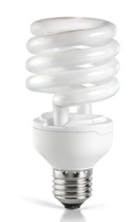I’m Beginning To See The Light
BY Paul Feuerstein, DMD
CFL
These bulbs are to be replaced by alternative bulbs, currently compact fluorescent lightbulbs (CFL) or light-emitting diodes (LEDs).
The CFLs are the curly shaped bulbs that screw into your existing sockets and cost five to six times more than incandescent bulbs. The savings come from the fact that they use one-fourth the energy and last 10 times longer. Incandescent lamps still have a few advantages compared to CFLs. The color rendition of incandescent lamps is superior to CFLs, and incandescents also project light farther. CFLs are an advantage in high locations or hard-to-reach places because they last longer and do not need to be changed as often.
Some reports note that the light output of CFLs diminish over time. Special, more expensive models are required if you want to be able to dim them. Dimming a standard CFL can shorten bulb life and will void the warranty of certain manufacturers.
LED
LEDs have taken the world by storm as an alternative light source. In our increasing “green” initiatives, these light sources fit the bill since they are energy efficient and their long life keeps them out of landfills.
According to several articles, “white light, light-emitting diode lamps have longer life expectancy and higher efficiency than most other lighting. LED sources are compact. This gives flexibility in designing lighting fixtures and good control over the distribution of light with small reflectors or lenses.”
Because of the small size of LEDs, they can be combined in groups that yield flexible light output situations. LED lamps have no glass tubes to break, and their internal parts are rigid. This makes them resistant to vibration and impact. With proper design, an LED lamp can be used with a dimmer or have preset light output (like your incandescent bulb’s 50-100-150 types).
Dental offices have started using more LEDs in many lighting situations. Handpieces now have LEDs at the connector end, eliminating the heavy, bulky fiberoptic hoses. A new generation of LED headlights are smaller, brighter and weigh less than 8 grams. Manufacturers of magnifying loupes make corresponding LED lights, but several independent companies have light systems that can be used universally with loupes, standard eyglasses or protective eyewear.
Our overhead chair lights are undergoing an amazing transformation. It is a long way from the huge Ritter lights with giant glass collimators and hot bulbs that need frequent replacement.
The new generation of chair lights uses LEDs and different aiming (collimation) systems. These need far less energy to operate, do not generate heat (so those inquiring patients will not burn their fingers), and last years longer before needing replacement. This is surely part of “going green,” which is being demanded by today’s consumers.
Pelton & Crane took the lead by bringing in the Helios 3000, which resembles (in shape) the company’s line of lights. But it is actually quite different. The parabolic reflector/collimator aims the light in a precise rectangle that allows full, white light illumination. Because of the product’s design, it almost eliminates shadows. There are also switches that reduce intensity and emit an orange glow to prevent curing of composites.
DentalEZ followed with a totally new design with its EverLight. It has an array of LEDs, both full spectrum and composite-friendly. Rather than using collimation, the LEDs are aimed at a specific area that covers the entire oral cavity.
Belmont recently introduced a round, ring-shaped light that not only looks futuristic, but is touch-free. You just wave your hands over the light to turn it on and off. The newest light at press time is the Midmark LED unit, which will most likely be followed by variations from the operatory light manufacturers.
This revolution/evolution should continue over the next few years. Visit your local dental dealers and attend meetings with exhibitors to see these new lights. You will find them indispensable in your practice.
Dr. Paul Feuerstein installed one of dentistry’s first computers in 1978. For more than 20 years, he has taught technology courses. A general practitioner in North Billerica, Mass., since 1973, Dr. Feuerstein maintains a website (www.computersindentistry.com), and can be reached at [email protected].
Past DE Issues


